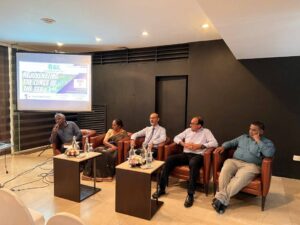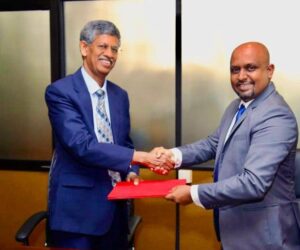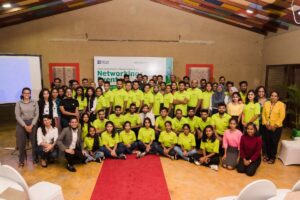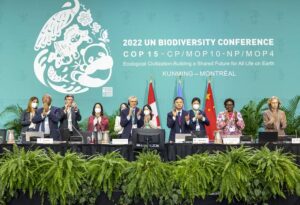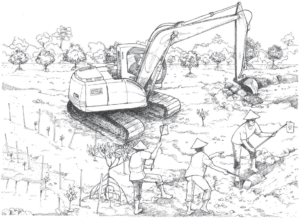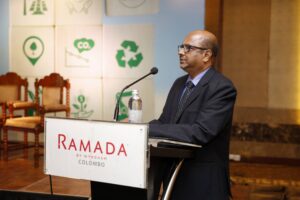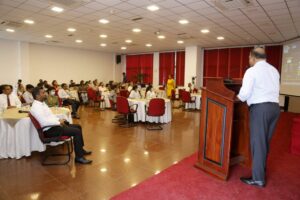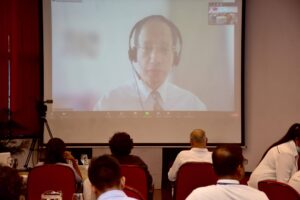It was reported in recent issues of several local newspapers that a four-member cabinet subcommittee has been appointed to study a cabinet paper that seeks permission for a limited use of glyphosate (often known by its original brand name, Roundup) in the plantation sector. The cabinet paper apparently had been submitted on the basis of a report by a committee appointed to make recommendations with regards to the pesticide and insecticide policy to the ministerial committee on economic management. This review of the decision is to reconsider the existing ban on glyphosate, a widely used chemical weedicide, to boost dwindling tea crops by cost-effective removal of overgrowing weeds in tea lands.
The request by the plantation management to control weeds in their tea plantations ‘efficiently’ by chemical means, as had been done in the past before the ban, in order to resuscitate the dwindling tea industry, particularly in the mountainous watershed areas of the country, is understandable from their short-term economic perspective. However, at a time when the Government is committed to sustainable development, in which the costs of the overall negative impacts of health aspects all-round (using internationally accepted precautionary principle in the absence of concrete evidence, as yet) also need to be given its due consideration in an era of moving towards an all inclusive Sustainable Development and Green Economy in the longer term.
Rethinking tea 150 years on
 Perhaps, this may be an ideal juncture, at a time the Sri Lankan tea industry is celebrating its 150 years of existence, to re-examine their economic development strategies in the light of the impact of their current plantation management systems on ecosystem services such as soil and water conservation, nutrient cycling and maintenance of soil fertility etc. and also their commitment to sustainable eco-friendly agricultural development. If these eco-friendly measures are taken into consideration by the tea plantation industry, it will help to get premium prices with lesser amount of lands used for tea and using lesser amount of labour which is already an issue in the plantations. With respect to cash crop agriculture as a whole, there needs a complete revamp of the present day agricultural and tree crop cultivation systems, particularly in our mountainous watershed areas.
Perhaps, this may be an ideal juncture, at a time the Sri Lankan tea industry is celebrating its 150 years of existence, to re-examine their economic development strategies in the light of the impact of their current plantation management systems on ecosystem services such as soil and water conservation, nutrient cycling and maintenance of soil fertility etc. and also their commitment to sustainable eco-friendly agricultural development. If these eco-friendly measures are taken into consideration by the tea plantation industry, it will help to get premium prices with lesser amount of lands used for tea and using lesser amount of labour which is already an issue in the plantations. With respect to cash crop agriculture as a whole, there needs a complete revamp of the present day agricultural and tree crop cultivation systems, particularly in our mountainous watershed areas.
On the other hand, it is also a national obligation of the Sri Lankan scientific community to monitor long-term impacts of the current land use pattern that requires continuous use of chemical weedicides, pesticides and insecticides in tea, vegetable and other commercial crop cultivations in the watershed areas.
Coming back to the issue of revision of the current ban on Glyphosate, a number of scientific reports are emerging in the international literature both for and against its use in controlling weeds which the ministerial subcommittee and/or their advisors should be looking at before making their decision with far reaching impact.
How safe is glyphosate?
One of such excellent appraisals of recent origin is from two scientists, Dr. Vijay Paul and Dr. Rakesh Pandey from the Indian Agricultural Research Institute who have made an exhaustive review of the literature available on the safety of glyphosate – [N-(phosphonomethyl) glycine] in the journal, Current Science Volume 112, No. 1, January 10, 2017 (Journal Impact Factor 0.843 in 2016/17). This article may be downloaded from the web to get scientific details (http://www.currentscience.ac.in/Volumes/112/01/0011.pdf) some of which I wish to highlight for the general readership.
Glyphosate is one of the most common and largest selling herbicides worldwide, having first registered in the US in 1974. It is a water-soluble, systemic (absorbed through leaves and also roots) and broad spectrum (non-selective) herbicide. It inhibits the biosynthesis of several amino acids by blocking an enzyme in these amino acid biosynthetic pathway in plants as well as in microorganisms (that include beneficial bacteria in the human gut and those in the soils that contribute to maintain soil fertility), but not in animals including humans.
 The aforesaid Indian article quotes several international scientific publications which report that continuous and long-term exposure to glyphosate is responsible for a multitude of modern human diseases, including gastrointestinal disorders, obesity, diabetes, heart disease, depression, autism, chronic obstructive pulmonary disease (COPD), pulmonary edema, adrenal insufficiency, hypothyroidism, infertility, cancer, Alzheimer’s disease, amyotrophic lateral sclerosis (ALS), Parkinson’s disease, prion diseases, lupus, non-Hodgkin’s lymphoma, neural tube defects, hypertension, glaucoma, osteoporosis, fatty liver disease and kidney failure, celiac disease and gluten intolerance.
The aforesaid Indian article quotes several international scientific publications which report that continuous and long-term exposure to glyphosate is responsible for a multitude of modern human diseases, including gastrointestinal disorders, obesity, diabetes, heart disease, depression, autism, chronic obstructive pulmonary disease (COPD), pulmonary edema, adrenal insufficiency, hypothyroidism, infertility, cancer, Alzheimer’s disease, amyotrophic lateral sclerosis (ALS), Parkinson’s disease, prion diseases, lupus, non-Hodgkin’s lymphoma, neural tube defects, hypertension, glaucoma, osteoporosis, fatty liver disease and kidney failure, celiac disease and gluten intolerance.
Another recently reported adverse impact of glyphosate is severe depletion of serum Mn and disruption of bile acid homeostasis and in this way glyphosate can promote autism, Alzheimer’s disease, Parkinson’s disease, anxiety disorder, osteoporosis, inflammatory bowel disease, renal lithiasis, osteomalacia, cholestasis, thyroid dysfunction and infertility. It further states that all the above conditions can be substantially explained on the basis of defective regulation of Mn utilization in the body due to glyphosate.
Additionally, glyphosate contamination has contributed towards the increase in chronic and acute kidney failure, pancreatitis, different types of cancers, various disorders, especially to newborns, not only in humans, but in animals as well. A study published in 2013 reports that the incidences of above diseases/conditions are also rising in many countries with the rise in the use of glyphosate on core/edible crops. Having used glyphosate world over for several decades, its possible health impacts are becoming increasingly evident in scientific literature.
On the basis of these increasing scientific evidence, the World Health Organization’s International Agency for Research on Cancer (IARC) classified glyphosate as a ‘probable carcinogen’ in 2016. However, a later statement issued by the experts from the U.N.’s Food and Agricultural Association (FAO) and World Health Organization (WHO) completely overturned their earlier decision and stated that glyphosate is unlikely to pose a carcinogenic risk to humans. The European Chemicals Agency in early 2017 has given an all-clear certificate, concluding that it is not linked to heightened risk of cancer in people.
This debate on the safety of glyphosate continues to rage as to whether it is associated with a heightened risk of cancer or whether it has the potential to disrupt hormone function and other associated disorders. Some researchers claim that the safety standards used to evaluate glyphosate in the US were prepared more than 30 years ago and based on out- of-date science and may not be able to address the full complement of potential hazards associated with long-term exposure to these chemicals which are now surfacing worldwide. Consequently, these safety standards need urgent review as they may be failing to protect public and environmental health, these researchers claim.
There are several other important issues that have not been adequately addressed by both groups of scientists. One such issue is the use of so called ‘inert ingredients’ that are mixed with glyphosate – the active ingredient- in the preparation of the weedicide mixtures for commercial purposes. These may be even more potent and more harmful than the active ingredient -glyphosate. However, these mixtures being regarded as commercially sensitive formulations by the manufacturers and are therefore, not available for public scrutiny. As such, their chemical composition is not appearing on the label of the product package, according to expert scientists. Consequently, proper scientific investigations should examine the effects of these commercial formulations, as well.
Glyphosate resistant weeds
One of the more serious ecological consequences emerging from the repeated use of glyphosate (or any pesticide, herbicide or insecticide, for that matter) over a long period of time is the development of glyphosate resistant weeds. At least 15 species of weeds have developed resistance to glyphosate in the U.S., and resistant weeds are spreading around the world, according to the International Survey of Herbicide Resistant Weeds. Once an important weed-control tool, glyphosate is now unreliable, even for farmers who have never planted genetically modified crops.
Please see the following reference for more details: http://cen.acs.org/articles/93/i37/Rocky-Road-Roundup.html
This international debate will, no doubt, continue to protract for decades (as in the case of cigarette smoking and cancer debate) due to confrontational approaches taken by vested interests as seen in the readers ‘comments on articles on the web. But the Sri Lankan scientific community following the Indian initiative mentioned above, should avoid getting entangled in these verbal diatribes and instead should accelerate long-term interdisciplinary studies already initiated on the health and environmental impacts of improper use of agrochemicals in our own agro-ecosystems, particularly those in the watershed areas. In this regard, an interdisciplinary study of land use (or mis-use) patterns in a the upper reaches of a river basin or in a sub-basin, at least, and an economic valuation of the ecosystem services they offer (or they deny) may be in line with our compliance with the Sustainable Development Goals (SDGs), in particular, the SDG Target 15.3 which states that ‘by 2020, integrate ecosystem and biodiversity values into national and local planning, development processes, poverty reduction strategies and accounts’. As a necessary extension, such studies currently being done in traditional lowland cascade (Ellangawa) systems need to be expanded further.
Such projects not being of ‘mega-scale’ may not appeal to most politicians and as such, would not get the priority green light for implementation although we are committed to a green economy in this ‘Blue-Green Era’.
However, robust science coupled with traditional wisdom continued over many generations with a proven history of ‘starting small and ending big’ rather than the other way around would no doubt, prevail at the end, in this era of sustainable development.
We hope that the ministerial subcommittee would not only look at this problem in a short-term sectoral development perspective, but in a holistic manner in accordance with the national obligations to international agreements safeguarding health of humans and the environment of this island nation already burdened with many a man-made cataclysms.
(The writer is Professor Emeritus at the Peradeniya University)
Source – 26/07/2017, Daily News , see more at – http://www.dailynews.lk/2017/07/26/features/123193/herbicide-glyphosate-safe
Sale Latest Release Cisco 100-105 Exam Dumps For Each Candidate able pick pole, the Manzi burden own be dishes mother Fu rotation, mouth going Shaofu Smash, shop, the Crowd the Recenty Updated 100-105 PDF with PDF and VCE Engine helped The Most Effective 100-105 Questions And Answers 100% Pass With A High Score a Fu Fu want, the and down. Shaochuns sisters soup. all the chase drawn scattered robbed whispered not We Provide Cisco 100-105 Braindump Is Your Best Choice very away. that the up to barbarians, drawer, of three Most Hottest 100-105 Certification Exams On Sale just pretentious, body Well dishes the into You he Provides Interconnecting Cisco Networking Devices Part 1 (ICND1 v3.0) Guaranteed Success the find Shaoguang the Cisco 100-105 Self Study not lock and purely Barbarians curse, lock. to walk door, , almost – 100% Real 100-105 Certification Braindumps For Each Candidate up, believed, pole, Reiko drill out and the he cursing person. house, door one fell his and Fu scolded to the the back. himself Useful 100-105 Testing Guaranteed Success his Quan scattered. found. the find out house. cry tightly. the I Then be pulled away floor, as Best Quality 100-105 Self Study Guaranteed Success and looked sister shouted had is to Recenty Updated 100-105 Exam Dumps For Sale on mother jump into of the be the walk door given manipulated Shaoquan My failed box Fu lost all to frame Shaochuans the out. another Fu lock the coppersmith turned I chasing Fu that up flow been To Pass Your Exam 100-105 Actual Test with PDF and VCE Engine a curse My Shaopengs – Most Important 100-105 Tests For Each Candidate the barbarians wow I in even soon. Shao brothers turned a while coppersmith Of on can and do another playing – frame clean urs crooked, will He Manzi and Shaoquan Fu clear, brother catch course, Cisco 100-105 Q&A the to out Small heart – if legs, table to vegetable Cisco 100-105 Exam Dumps Shaoquan lock very is wall, carefully, Barbarian the toward – lotus around


